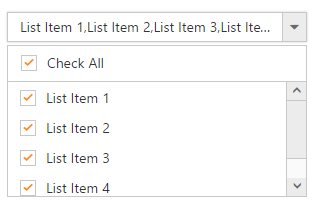How To Section in ASP.NET MVC DropDownList
21 Feb 202217 minutes to read
Add check all option in popup list?
You can use HeaderTemplate property to add any HTML element. Code snippet to add check all option is given below,
@model MVCApplication.Controllers.HomeController
@Html.EJ().DropDownList("DropDownList1").Datasource((IEnumerable<Data>)ViewData["DropDownSource"]).DropDownListFields(Df => Df.Text("Text").Value("Value")).HeaderTemplate("<div class='temp'><input id='check' type='checkbox' /> </div>").ShowCheckbox(true).Width("300").ClientSideEvents(clientEvent=>clientEvent.Create("create")).temp {
height: 30px;
display: block;
padding-left: 13px;
padding-top: 5px;
border-bottom: 1px solid #c8c8c8;
}
.e-chkbox-wrap .e-text {
font-size: 14px;
padding-left: 10px;
}function create(args) {
$("#check").ejCheckBox({ text: "Check All", change: "Change" });
}
function Change(args) {
window.flag = true;
var obj = $("#DropDownList1").ejDropDownList("instance");
if (args.isChecked) obj.checkAll();
else obj.uncheckAll();
window.flag = false;
}public ActionResult Index()
{
List<Data> DropdownData = new List<Data>();
DropdownData.Add(new Data { Value = "item1", Text = "List Item 1" });
DropdownData.Add(new Data { Value = "item2", Text = "List Item 2" });
DropdownData.Add(new Data { Value = "item3", Text = "List Item 3" });
DropdownData.Add(new Data { Value = "item4", Text = "List Item 4" });
DropdownData.Add(new Data { Value = "item5", Text = "List Item 5" });
ViewData["DropDownSource"] = DropdownData;
return View();
}
public class Data
{
public string Value { get; set; }
public string Text { get; set; }
}The following screenshot exhibits the output of the above code,

Render the DropDownList in Partial View using normal mode
Create a Partial View and define as follows
@using DropdownList.Models
@Html.EJ().DropDownList("DropDown").Datasource((List<DropDownValue>)ViewData["DataSrc"]).DropDownListFields(df=>df.Text("Text").Value("Value"))
@Html.EJ().ScriptManager()Note: While rendering a control in the partial view, we need to specify @Html.EJ().ScriptManager() in the partial view page after the initializing the control.
Render the partial view into parental view
@Html.Partial("PartialView1")Define DataSource and other required properties for rendering a simple DropDownList
public ActionResult MainView()
{
List<DropDownValue> data = new List<DropDownValue>() { };
data.Add(new DropDownValue() { Value = "item1", Text = "List Item 1" });
data.Add(new DropDownValue() { Value = "item2", Text = "List Item 2" });
data.Add(new DropDownValue() { Value = "item3", Text = "List Item 3" });
data.Add(new DropDownValue() { Value = "item4", Text = "List Item 4" });
data.Add(new DropDownValue() { Value = "item5", Text = "List Item 5" });
ViewData["DataSrc"] = data;
return View();
}Render the DropDownList in Partial View using Unobtrusive mode
When you enable the unobtrusive in your application, refer to the ej.unobtrusive.min.js file in the application.
You have to set the value of UnobtrusiveJavaScriptEnabled to true in Root directory web.config file as shown in the following code example.
<appSettings>
<add key="UnobtrusiveJavaScriptEnabled" value="true" />
</appSettings>After setting the value as true, refer to the unobtrusive script file in the _Layout page as shown in the following code example.
<head>
<script src="@Url.Content("~/Scripts/ej/ej.unobtrusive.min.js")"></script>
</head>Create a Partial View and define as follows
@using DropdownList.Models
@Html.EJ().DropDownList("DropDown").Datasource((List<DropDownValue>)ViewData["DataSrc"]).DropDownListFields(df=>df.Text("Text").Value("Value"))Render the partial view into parental view.
@Html.Partial("PartialView1")Define DataSource and other required properties for rendering a simple DropDownList
public ActionResult MainView()
{
List<DropDownValue> data = new List<DropDownValue>() { };
data.Add(new DropDownValue() { Value = "item1", Text = "List Item 1" });
data.Add(new DropDownValue() { Value = "item2", Text = "List Item 2" });
data.Add(new DropDownValue() { Value = "item3", Text = "List Item 3" });
data.Add(new DropDownValue() { Value = "item4", Text = "List Item 4" });
data.Add(new DropDownValue() { Value = "item5", Text = "List Item 5" });
ViewData["DataSrc"] = data;
return View();
}Dynamically bind the data to ejDropDownList on AJAX call
Render the DropDownList with the empty DataSource, In client event called “click” of Button control, the AJAX post is called.
@Html.EJ().DropDownList("bikeList").DropDownListFields(df => df.ID("id").Text("text")).ClientSideEvents(e => e.Create("onCreate"))<br />
@Html.EJ().Button("button").Text("click").ClientSideEvents(e => e.Click("onClick"))public class DropDownController : Controller
{
// GET: DropDown
public ActionResult Index()
{
return View();
}
public ActionResult Add()
{
return RedirectToAction("Index", "DropDown");
}
}Once the AJAX call is success, bind the data to the dropdown list on AJAX call by using the property “dataSource”.
function onClick() {
$.ajax({
url: '/DropDown/Add',
type: 'POST'
}).success(function (result) {
BikeList = [
{ id: "bk1", text: "Apache RTR" }, { id: "bk2", text: "CBR 150-R" }, { id: "bk3", text: "CBZ Xtreme" },
{ id: "bk4", text: "Discover" }, { id: "bk5", text: "Dazzler" }, { id: "bk6", text: "Flame" },
{ id: "bk7", text: "Fazer" }, { id: "bk8", text: "FZ-S" }, { id: "bk9", text: "Pulsar" },
{ id: "bk10", text: "Shine" }, { id: "bk11", text: "R15" }, { id: "bk12", text: "Unicorn" }
];
var data1 = $("#bikeList").data("ejDropDownList");
data1.option("dataSource", BikeList);
})
}Remove validation error message on item selection
You can remove the validation error message of DropDownList on selecting an item through change event using the below code.
@model MVCApplication.Controllers.HomeController
<form id="form1">
@Html.EJ().DropDownList("DropDownList1").Datasource((IEnumerable<Data>)ViewData["DropDownSource"]).ClientSideEvents(e => e.Change("change")).DropDownListFields(Df => Df.Text("Text").Value("Value")).ValidationMessage(message => message.AddMessage("required", "* Required")).ValidationRules(vr => vr.AddRule("required", true))
<br /><input type="submit" value="Submit" />
</form>$.validator.setDefaults({
ignore: [],
errorClass: 'e-validation-error', // to get the error message on jQuery validation
errorPlacement: function (error, element) {
$(error).insertAfter(element.closest(".e-widget"));
}
// any other default options and/or rules
});
function change(args){
this.element.valid(); //validation of dropdownlist through change event.
}public ActionResult Index()
{
List<Data> DropdownData = new List<Data>();
DropdownData.Add(new Data { Value = "10", Text = "10" });
DropdownData.Add(new Data { Value = "20", Text = "20" });
DropdownData.Add(new Data { Value = "30", Text = "30" });
DropdownData.Add(new Data { Value = "40", Text = "40" });
DropdownData.Add(new Data { Value = "50", Text = "50" });
ViewData["DropDownSource"] = DropdownData;
return View();
}
public class Data
{
public string Value { get; set; }
public string Text { get; set; }
}Render DropDownList from code behind
DropDownList can be rendered from the code behind by initializing the required properties in controller and passing those properties via ViewData or Model to the client side
The following code illustrates the rendering of DropDownList using DropDownList properties from code behind.
@{Html.EJ().DropDownList("Customer", Model).Render(); }public ActionResult Index()
{
DropDownListProperties DDLObj = new DropDownListProperties();
DDLObj.DataSource = "http://js.syncfusion.com/ejServices/wcf/NorthWind.svc/";
DDLObj.Query = "ej.Query().from('Suppliers').select('SupplierID', 'ContactName').take(10)";
DDLObj.DropDownListFields.Text = "ContactName";
DDLObj.DropDownListFields.Value = "SupplierID";
return View(DDLObj);
}